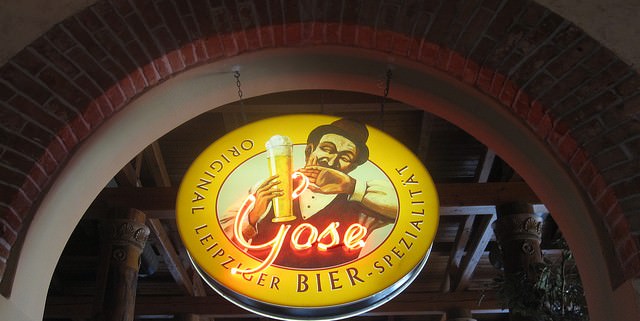Gose: Why This Salty Beer Should Be on Your Restaurant Beer Menu
In the 1940s, Gose disappeared, but this thousand-year-old salty beer from Germany is making a comeback—and it just might be a great fit for your restaurant. Not only does this beer have a unique taste, it also features a comeback story that will get your customers wanting to try it out. Here’s why Gose just might be the unique drink you’ve been looking to add to your restaurant beer menu.
What is Gose?
Gose, pronounced “gose-uh” (like “rose-uh”) is an ancient German sour beer. While some sour beers can be a bit, er, aggressive, Gose has been referred to as “a gateway sour beer” that can be made without deliberately infecting the brew with bacteria. The beer was a German staple way back in the day; there are reports that it was a favorite of Emperor Otto III—who ruled Germany between 983 and 1002.
As a simple description, Gose is beer made with half malted wheat and half malted barley. It’s spiced with coriander and hops.
Okay, but why is it salty?
According to the historical record, Gose beer was first brewed in Goslar, Germany, a mining town 100 miles west of the Gose river. The minerals from the mountains around the town had leeched into the water supply, giving the water a decidedly salty taste. Since the Gose river was the only place to source water for beer, all the inhabitants grew accustomed to, and then vastly preferred salty beer.
When the Goslar mines died out in the Middle Ages (seriously people, this is an ancient beer), Gose brewers moved to Leipzig.
That’s where Gose really took off.
Because Leipzig had better quality water, brewers there began to purposefully add salt to the beer. The taste was so addictive that by 1900, there were over 80 licensed Gose breweries in the town.
Consider: Does your town have 80 licensed breweries?
You mentioned something about a comeback story?
Is there ever!
In the war-torn 20th Century, Gose was hit hard by a long-lasting triple threat: bad economy, air raids, and the Communist split that broke Germany into West Germany and East Germany. Leipzig was in East Germany (which was the Communist side).
Communist East Germany determined that the bulk of grain grown in the Republic should be used for bread instead of beer, so we can safely assume that the one by one, the Gose breweries shut their doors.
According to Wikipedia, by the late 1940s, only one person in the world still knew how to brew Gose. His name was Friedrich Wurzler, and when he died in 1966, the secret of Gose brewing was lost.
Or so we thought.
It turns out that before he died, Wurzler shared the secret of Gose brewing with his son, and after the Berlin Wall came down on November 9, 1989, Leipzig was once again free to make the rare, salty beer for which they had been known. Brewers tracked down the recipe, batches were brewed, the old folks who remembered Gose’s taste were consulted for quality and recipe effectiveness, and all seemed like it would turn out well for the famous Gose beer.
But Gose beer still had a fight on its, er, hands. (Its head?)
It turns out that once Gose was reintroduced on the beer scene, it was found to be illegal. To be exact, the coriander in the beer was in violation of the Reinheitsgebot, the German Beer Purity Law.
Even though the purity laws had been around since 1487, Gose had never run afoul of the regulations until it was brought back from near-extinction. Appeals were made, concessions were granted, and in 2000, Gasthaus & Gosebrauerei Bayrischer Bahnhof (Gose Brewery Bavarian Station) was the first brewery to brew Gose since World War II.
Yay!
Enough with the history lesson! Where can I get Gose?
Now, there are at least four German breweries that make Gose, as well as a number of small American craft breweries, including Westbrook Brewing Co (South Carolina), Off Color Brewing (Chicago), and Lost Nation Brewing (Vermont). Want some variety? Cascade Brewing creates a unique Gose every season.
How do I describe it?
Gose is known for its tall head (due to the protein in the wheat) its smell of coriander, lack of bitterness, and its sour, spicy taste. It has been described as tasting like green apple, dried apricot, zest, and banana. It has a dry, crisp finish, it makes your mouth pucker just slightly, and it’s extremely refreshing…just don’t forget that it’s salty!
If your customers are looking for a not-so-sour, not-so-hoppy session beer, Gose should be your go-to recommendation.
How do I serve it?
Gose can be served on its own as a sipping beer, but it’s also great to pair with salty foods, such as raw oysters, smoked fish, and other fishy dishes. In addition, Gose makes for a great beer cocktail; just add raspberry syrup, aquavit, or Kümmel, a caraway / cumin liqueur, also from Germany.
In conclusion
You already know that your wines tell a story, but what about the stories your beers tell? Are your servers telling those? Add Gose to your menu and share its comeback tale, and your restaurant may also experience the longevity that this ancient German beer has enjoyed.
Here’s to salty beer!
Photo licensed by Bernt Rostad
- Why Your Wine Menu Is Scaring Your Guests - February 27, 2015
- How to Host a Better Restaurant Week and Get More Customers - February 23, 2015
- Choosing Your Restaurant Wine Glass – 3 Approaches - February 16, 2015









